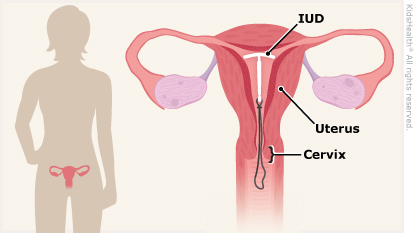An IUD (intrauterine device) is a piece of T-shaped plastic, about the size of a quarter, that is placed inside the uterus to prevent pregnancy. Two types of IUDs are available: copper and hormonal. An IUD is one of the best ways to prevent pregnancy. Some types can stay in place for up to 10 years.




What can I expect after the IUD is put in? Irregular bleeding is common for at least 2 days after the IUD is put in. The bleeding can continue for 6 weeks or longer, but usually gets better over time. If the bleeding continues past 6 weeks, talk to your health care provider about ways to make it better.
What problems can happen? Most IUDs do not cause any problems. Very rarely, when the health care provider puts the IUD in, it can push through the wall of the uterus, or bacteria (germs) can get into the uterus and lead to pelvic inflammatory disease (PID).
Rarely, an IUD can come out of the uterus by accident. Someone might not know this has happened. If an IUD comes even part of the way out, it does not protect against pregnancy. It's important to follow up with your health care provider as instructed so they can make sure the IUD is in place.
IUDs do not cause problems with fertility (getting pregnant) after they are taken out and do not cause ectopic pregnancies (when a fertilized egg grows outside the uterus).
How do IUDs prevent pregnancy? Both copper and hormonal IUDs work by:
The hormonal IUD may also prevent ovulation (when an egg is released during the monthly cycle).
What if I have sex before the IUD is working and I don't use a condom or it breaks? Emergency contraceptive ("morning after") pills are available at drugstores without a prescription or ID. They delay ovulation (the release of an egg). This way, there is no egg for the sperm to fertilize. If the egg was already fertilized and implanted in the uterus wall, emergency contraceptive pills will not stop the pregnancy.